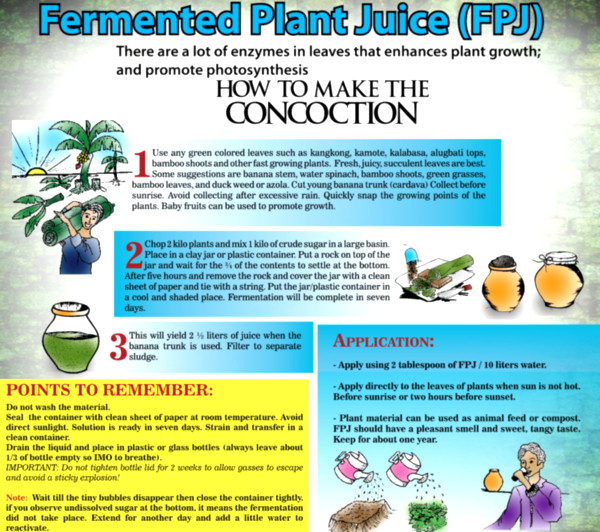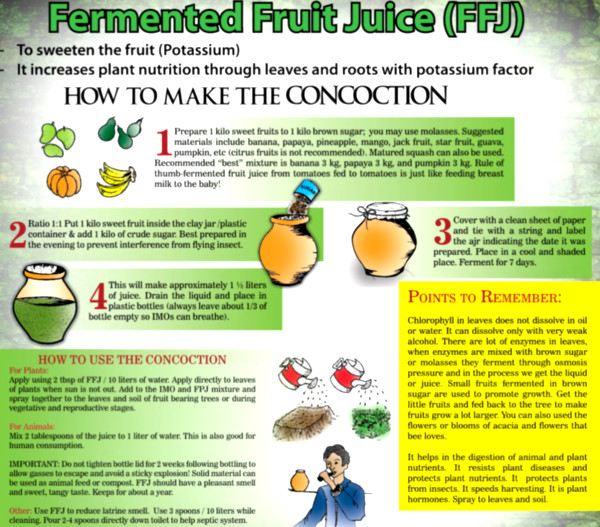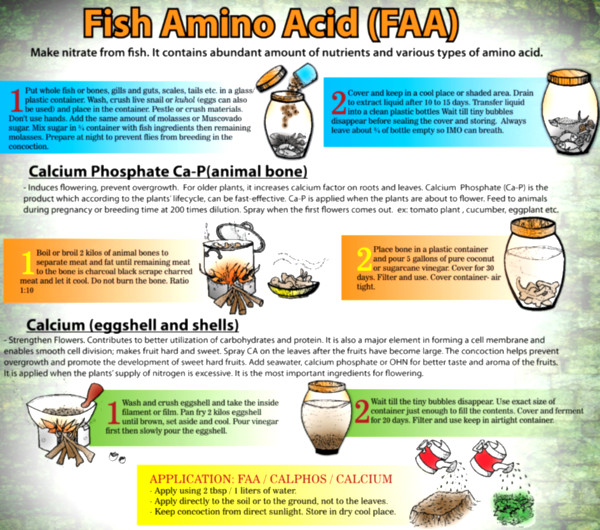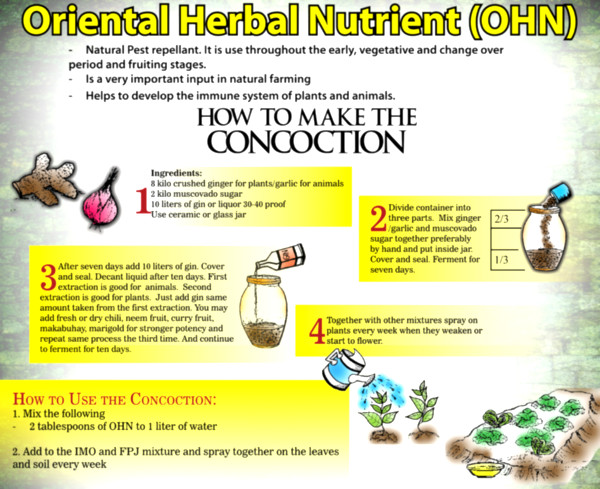The Philippines’ Department of Agriculture has been promoting the production of High Value Crops (HVCs) in order for farmers to earn higher income. Instead of using inorganic fertilizers, however, vegetable and fruit growers had been taught to use indigenous microorganisms (IMO) and fermented farm products as part of a nutrient management component based on the Korean Natural Farming (KNF). This is a system of farming which has been practiced in over 30 countries. This paper discusses the methods of preparing the common fermented farm inputs, particularly the Fermented Plant Juice (FPJ) and the Fermented Fruit Juice (FFJ). It likewise examines the variations in materials and processes and how these organic fertilizers from farm wastes are used in different areas in the Philippines.
Introduction
The Oil Crisis of 2008 created a big stir in the agriculture sector mainly due to the escalating prices of inorganic fertilizers. With prices of fertilizers tripled, farmers were forced to look for alternative sources (as always) of nutrients in which the Department of Agriculture (DA), through the bureau of Soils and Water Management (BSWM) responded with the Project on Rapid Composting as a part of the DA’s National Organic Agriculture Program addressed mainly to rice farmers. The project involves training and provision of shredders to capacitate farmers to produce their own organic fertilizers
The High Value Crops (HVCs) sector however, has been taking a slightly different tact. Vegetable and fruit growers had been using indigenous micro organisms (IMO) and fermented farm products as a part of Nutrient Management based on Korean Natural Farming (KNF) through the assistance of NGOs and SCUs in various training and extension programs.
“Korean Natural Farming” is a system of farming being practiced in over 30 countries. The basic premise in KNF is that farmers can generate most, if not all, of the necessary inputs to food production onsite. It is also the premise in the Philippine National Standard for Organic Agriculture. KNF is a holistic approach to farming that utilizes the nature’s powers for maximum performance rather than human intervention. “Natural materials instead of chemicals as its unique inputs. Materials are locally available and cheap, and the farming inputs are made by the farmers instead of being purchased from the market; thus lowering cost for the farmers and converting waste into resources. Being “farmer-friendly,” it is also being used as a tool to improve the living of the poor farmers in the third world.” (Cho Han Kyu President of Janong Natural Farming Institute March, 2004).
He attributed Natural Farming to three formless teachers and three human teachers. The three formless are God, Nature, and conscience. As now being regarded by many, the gains from `Green Revolution’ is instant but the outcome is short term. We are now seeing the adverse effects of chemical fertilizers and pesticides not only on the soil that becomes acidic and low in organic matter, ground water contamination, adverse health effects but also on social and economic decay the latter due to the concentration of wealth on a few big companies.
In contrast, Natural Farming is a sustainable way of farming making use of all inputs from natural materials, observes the law of Nature and respects the rights of crops and livestock. It heals the soil damaged by chemicals, herbicide and machines. In the words of the farmer practitioners… “The soil becomes virgin again”. And ” With chemical agriculture they get sick before harvesting the rice paddies, now not anymore”.
Common Fermented Farm Inputs
Fermented Plant Juice (FPJ)

Fermented plant juice (FPJ) or Bless Green Soup or Tenkei Ryokujyu is made by fermenting plant parts in brown sugar. Sprouts and baby fruits with high hormone concentration, full grown fruits, flower abundant in honey, and any plant with strong vigor are good ingredients. (http://www.janonglove.com/janong/bbs/board.php?bo_table=e_JN5 ).
It is an ingredient in bokashi production and can also be used by applying directly to soil and plants. FPJ is produced by the fermentation of plant leaves, grasses, thinned crop plants, auxillary buds and/or young fruits and flowers (Jensen et al, 2006). It contains plant growth hormones and micronutrients that stimulate the growth of beneficial microorganisms. The common materials being used in the Philippines are kangkong (Ipomoea aquatica), sweet potato (Ipomoea batatas) and kakawate leaves (Gliricidia sepium).
Materials (FPJ)
Plant materials: leaves, grass, buds, young fruits, etc.
Raw sugar or molasses at the rate of 1/3-1/2 of the plant material
Procedure (FPJ)
1. Collect the materials early in the morning. Chop and finely mix these with sugar or molasses.
2. Place the mixed material in a suitable container such as earthen jar, or plastic drum if prepared in big volumes
3. Cover the pot or drum with paper or cheese cloth
4. Store in a cool dark place for 7-10 days to allow fermentation. The juice will change color from dark green to yellow brown or brown and would smell sweet and alcoholic.
5. After 7-10 days filter the material to extract the juice. Net bag can be used for small scale production. For big scale FPJ production, an improvised extractor or press can be used.
6. The FPJ can be stored in a glass or plastic bottle in a cool, dark place for up to 6 months. It is important not to tighten the cap completely on the bottle to allow aeration. Shake the bottle once a week to provide air to the microorganisms.
Application method (FPJ)
Dilute FPJ at the rate of 2 table spoonful per liter of water. Spray to plants or drench to the soil.
Fermented Fruit Juice (FFJ)

Fermented fruit juice (FFJ) is prepared in a similar manner to fermented plant juice (FPJ). It is used as a foliar spray to enhance fruit quality, as a feed supplement for animals, and as a food supplement for humans. In general, FFJ is generally used more during the flowering and fruiting stage.
Materials (FFJ)
Fruit peelings, over ripe fruits such as banana, papaya, watermelon, pineapple
Raw sugar or molasses
Procedure (FFJ)
1. Chop the over ripe fruits and peelings
2. Mix the materials with ½ part raw sugar or molasses. Other practitioners use 1:1 ratio.
3. Follow the same fermentation procedure as for FPJ.
4. Collect and store following the same procedure as for FPJ.
Application method (FFJ)
Use 1 tsp/5L water (minimum application rate for plants in healthy soil) or 1-2 tsp/L water (for plants in soil that is being rehabilitated) (Jensen et al, 2006). Apply to plants as a foliar spray.
Fish Amino Acid (Faa)

Fish amino acids are a good source of nitrogen for crop plants and may be used to supplement compost and manures in coastal regions which have a good supply of inexpensive fish byproducts. Some local government units (LGUs) such as Bayawan City in Negros Oriental is collecting fish trashes from the market for free and process this into FAA.
Materials (FAA)
Uncooked fish trash such as gills and intestines.
Raw sugar or molasses
Procedure (FAA)
1. Mix equal parts fish trash and brown sugar or molasses. Lactic acid bacteria serum (LABS) may be added to minimize the foul smell.
2. Place in earthen jar or any convenient container, cover with paper and allow the fish juice to extract and fermentation to occur for 14 days.
3. Filter out the solids and retain the liquid fish amino acids.
4. Store in glass or plastic bottles. Do not completely close the cap on the bottle.
5. Shake the solution weekly and add sugar to it every month (20% of the volume) as is done for IMO.
Application method (FAA)
Use 1-2 tbsp/L water and apply as soil drench or foliar spray weekly or depending on the vigor of the plants. High dosage can have adverse effects on plants.
Calcium Carbonate (Caco3) Preparation from Egg Shells
The main ingredient in eggshells is calcium carbonate. The shell itself is about 95% CaCO3 (which is also the main ingredient in sea shells) (Powrie, 1972). The remaining mass is composed largely of phosphorus and magnesium, and trace amounts of sodium, potassium, zinc, manganese, iron, copper and others, 27 in all.
The CaCO3 is not in soluble form. To convert it into soluble form heat or acid treatment is needed. The common method in KNF is the combination of the two agents, heating and use of natural vinegars.
Materials (CaCO3)
Egg shells or sea shells including snail shells.
Natural vinegar (made from coconut sap, sugar cane, pineapple or banana).
Procedure (CaCO3)
1. Burn or roast the shells in open fire or over a hot tin sheet until the color changes from brownish to black in color.
2. Grind or pound the shells to a powder consistency.
3. Place in a suitable jar or plastic container.
4. Add 5-10 parts natural vinegar. Shake to produce bubbles indicating a good reaction between the shell and the vinegar. The bubbles are due to CO2 being released.
5. Cover with paper and store in a cool dry place. The concoction may be shaken from time to time to speed up the reaction.
6. The water soluble calcium is ready in 7-14 days when there is no more bubbling.
7. Filter the preparation and put it in a new container (a glass jar).
8. CaCO3 has a long shelf life and can be stored for up to a year. Do not shake or add sugar to the CaCO3 solution during storage.
Application method (CaCO3)
Use 1-2 tablespoon per liter as foliar spray or soil drench specially at the start of flowering to improve fruit set and fruit quality.
Variations in Materials and Process
1. Materials in FPJ
Different materials are being used by farmers in preparing FPJ. The most common and easiest to use is banana pseudo stem, particularly the Saba or Cardaba variety. A high FPJ yield is obtained using this material. Some practitioners are using just the roots of banana (var. saba) and using spring water to dilute the FPJ.
2. Materials in FFJ
In FFJ, the materials being used are generally the most commonly available in the locality. In the case of the SOBAGROMCO squash and banana are the materials being used. Others use cucumber fruits, pineapple peelings, tomato and eggplant.
3. Materials in Caphos
The common material is egg shell for CaPhos but in areas where sea shells are abundant these are also being used. The shells of Golden Snail (Pomacea canaliculata Lamarck) is also commonly used. In SOBAGROMCO the animal bones from slaughter houses are collected and converted into organic inputs.
4. Process and Ingredients
There are generally two variations in the preparation of the fermentation products. The first one is just using the plant or fruit substrate and raw sugar or molasses. The second one involves the addition of one (1) part unchlorinated water. Water is added to hasten the fermentation process. Raw sugar or molasses is also adjusted to 1 part of the plant/fruit material.
To save on raw sugar or molasses, the rate of this ingredient is also being reduced by some growers to as low as 1/6-1/10 of the plant/fruit parts.
5. Application
The usual application rate is 1-2 tbs/liter of water applied as soil drench or as foliar spray. The combination of the different ingredients is based on the stage of plant growth. The KNFA recommends growth management on the basis of the Nutrioperiodism theory, which was developed and advocated by a Japanese horticulturist, Yasushi Inoue, in the 1930s. They emphasize the different nutritional requirements of crop plants at different growth stages. In Bayawan City, the proportion of the different preparations is 60:30:10 ratios depending on the stage of the plant. During the vegetative stage, it is 60% FAA, 30% FPJ and 10% FFJ. During the change-over, it is 60% FPJ, 30% FAA and 10% FFJ. During the fruiting stage, it is 60 % FFJ, 30% FPJ and 10% FAA.

Utilization of the Fermented Farm Products
1. Organic Banana
In organic banana production, the general guidelines in nutrient management are as follows:
1. Organic manure should only be seen as an additional fertilizer, and not as the main source of nutrients;
2. Regular application of organic material gained from cutting/pruning work helps to maintain a layer of humus and activity in the soil;
3. This includes adding dead leaves and pseudo-stems grown on the plantation as mulching material;
4. It is important that the material is spread evenly throughout the entire plantation;
5. These measures will suffice to maintain the fertility of the soil on sites suited to growing bananas, despite continual harvests.
The organic inputs are the foundation of organic banana production in Toril, Davao City by the Sibulan Organic Banana Growers Multi-Purpose Cooperative (SOBAGROMCO) and in Tupi, South Cotabato by the Sta Teresita Multi-Purpose Cooperative. Both cooperatives are using the different natural farm inputs and have made modifications suitable for their conditions. The proximate analysis of the fermented inputs in SOBAGROMCO is given below.
The rate of application depends on the soil analysis and target banana yields. In Toril, Davao City for Bungulan, the fertilization protocol is as follows:
Basal application- 3kg compost, 2kg vermi compost
Side dress- 20kg compost/6 months, 2kg vermicompost/3 months
Soil drench (Hinubig)- FAA, FPJ, FFJ, IMO at 60 ml/mat/month (pure)
2. Organic Pineapple
Among the HVCs, pineapple is probably the most difficult to grow organically specially for variety MD-2, which is the favorite variety for fresh pineapple for export. In organic pineapple production, FPJ and FFJ are being used as source of nutrients in addition to vermicompost and seaweed extract. The material for FPJ started with the use of swamp cabbage and muscovado sugar. But FPJ yield is low and cost is high.
The material being used now is banana pseudo stem with molasses instead of muscovado sugar. The other materials being used include wild sunflower and lemon grass which is also being used for pest control. The materials for FFJ includes banana and pineapple. They have also made an improvised press to facilitate the extraction of the liquids.
3. Organic Vegetables
Bacolod
In Bacolod City, the organization that is pushing forward organic agriculture is the Negros Island Sustainable Agriculture and Rural Development Foundation Inc. (NISARD).
Established as a result of a Memorandum of Agreement between the provinces of Negros Oriental and Negros Occidental, NISARD, is a non-stock non-profit foundation organization. Among the crops being produced organically by the members are lettuce, tomato, herbs, beans, sugarcane, banana and citrus (calamansi). Among the fermented farm inputs being used are FPJ, FFJ, Caphos, seaweed extract. An assorted of raw materials are being used as substrate for FFJ and FPJ.
Bayawan City
In Bayawan City, Negros Oriental, the LGU itself is producing the natural/organic farm inputs. They collect the vegetable trimmings and over-ripe fruits from the market for FPJ and FFJ. Fish trashes are also collected from the market for FAA and they use LABS to minimize the foul smell in the FAA. The farmers make CaPhos using both egg shell and shells of the golden snail. These products, FPJ, FFJ, FAA and CaPhos are sold to farmers at PhP 50/liter.
Preparations in Bayawan City for the fermented farm inputs has a slight variation in that water is used in both FPJ and FPJ, generally at about 30% by weight.
Surallah, South Cotabato
The organic farmers in the Municipality of Surallah are being assisted by The Don Bosco Foundation for Sustainable Development, Inc. (DBFSDI), formerly the DonBosco Diocesan Youth Center, Inc. (DBDYCI). The basic production system is based on Biodynamic Farming but parts of KNF are also being practiced as well as Agnihotra.
Agnihotra is a healing fire from the ancient science of Ayurveda. It is a process of purifying the atmosphere through a specially prepared fire performed daily during sunrise and sunset. It heals the environment and is being used for gardening and farming. For fruits and vegetables FPJ, FFJ and CaPhos are also being used.
Looking Forward
While these fermented farm inputs have been adopted by many organic farmers and the number is increasing, the academe has been slow in integrating these in their research and development agenda in improving production systems, largely content mainly on the elemental and inorganic chemistry of nutrient and pest management. Use of the natural inputs is sometimes regarded as unscientific. But science is actually just catching up.
Several government agencies and universities are slowly warming up to organics in general and are now including the natural farm inputs in their research and development programs as well as in extension. However in research, there is still the tendency to just `evaluate’ and `confirm’ the effects of FPJ and FFJ, etc. The research should be at a higher level to contribute positively to the improvement of these natural farm inputs. These can be through the use of locally available plant materials with specific growth promoting effects or addition of other naturally occurring materials/micro organisms to enhance specific effects.
An intriguing possibility is the integration of the preparation of natural farm inputs with the concepts in Biodynamic Farming. Such integration will not only enhance organic or biodynamic farming but will also remove the barriers of jargon and perception of exclusivity.
Although these preparations can be easily made by farmers themselves, it would also help more farmers if the preparations can be made commercially available. While some LGUs are already investing on these, the numbers are still too few. Several members of the private sector have also started investing on these natural farm inputs. But a few failed because of some technical problems on product shelf life and efficacy. Government support in such undertakings can help a long way in pushing this system of production so that agriculture can regain the lost virginity of the soil and purity of the environment.
References
Barcelon, E. J. 2004. Nature Farming Technology Systems. Mindanao Lumad and Muslim Development Center. 66p
http://www.agnihotra.org/agnihotra.htm
http://janonglove.com/janongusa/intro01.htmlf
http://www.thainaturalfarming.com/index.php?lay=show&ac=article&Id=38076
Jensen, H. L. Guilaran, R. Jaranilla and G. Garingalao. 2006. Organic amendments adopted and adapted by farmers in the Western Visayas region of The Philippines. Canadian International Development Agency (CIDA)
Maghirang, R. G. 2008. Organic banana production. Power point presentation
Naturland. 2001. Banana: Organic Farming in the Tropics and Subtropics
Powrie, W.D., 1972. Chemistry of eggs and eggs products. In: egg science and technology, Stadelman, W.J, and Cotterill, O.J.(Eds), pp (65-91), the AVI publishing company, INC. Westport, Connecticut.
Rodel G. Maghirang
Institute of Plant Breeding-Crop Science Cluster,
College of Agriculture, University of the Philippines Los Baños,
College, Laguna 4031, 2011-07-13
Source: http://www.agnet.org/library/eb/626/
thanks for this.
Tey art
i luv 8..